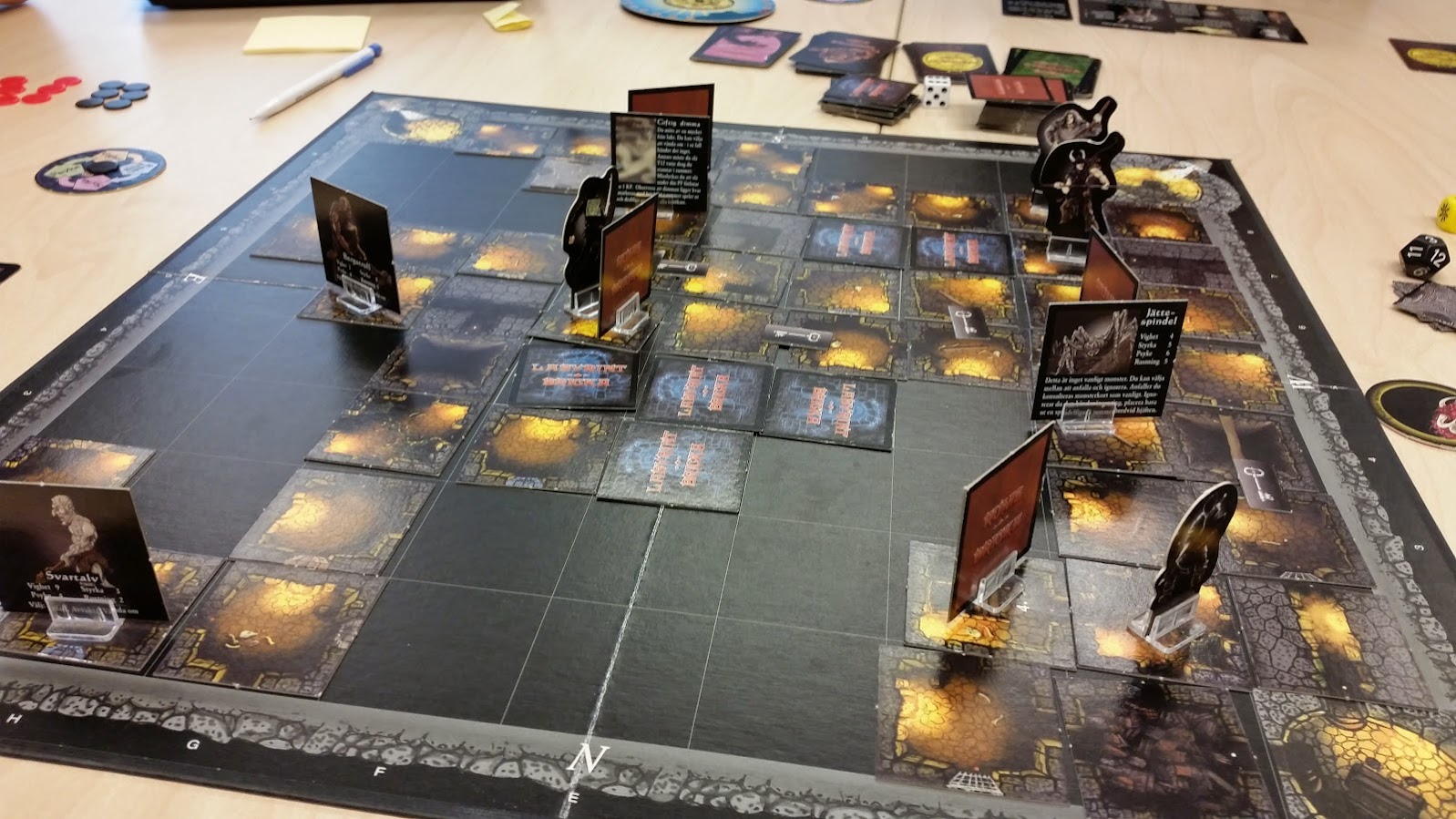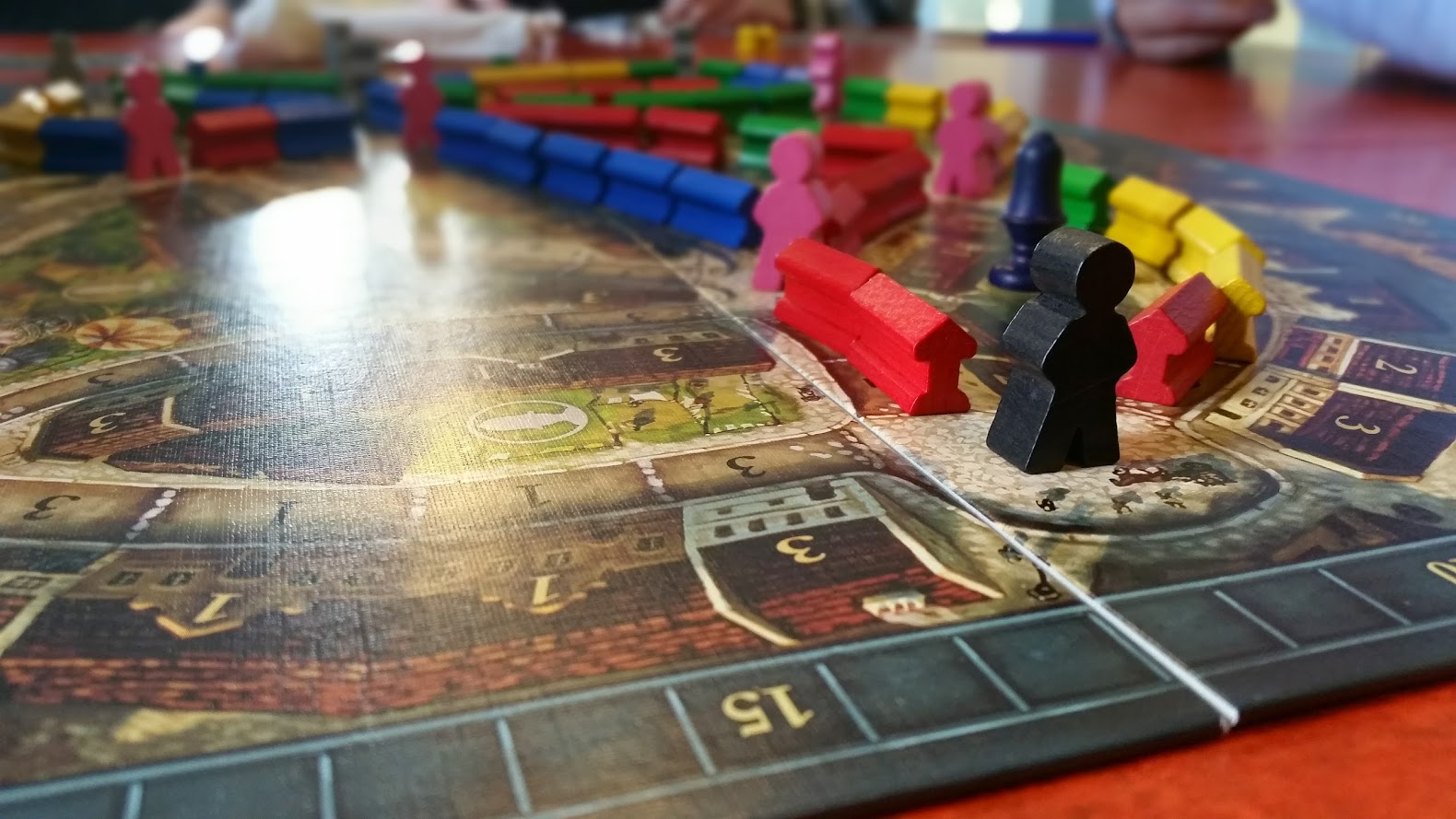This week the task to analyse a Board game of our choice was given. The task was to analyze the core system and the components to get a better understanding of game systems.
The group I’m in ended up with picking the game Drakborgen also known as DungeonQuest. The version we played was not the original from 1985, but the remake from 2002. This game is all about finding the most valuable loot while still making it out alive. This is done by exploring rooms, when entering a new room you can find anything from valuable loot to items or monsters.

Good Sides
The best parts of this game was that every time we played it turned out different than the previous times we played.
The Dragon Room had an interesting mechanic that made it motivating to stay even though the chance to wake the dragon were against you, it really shows how easy it is to be greedy and not get out in time. (Dragon Awakes)
Multiple ways to win, Having the most loot does you no good if you end up dying, sometimes its better to just stay in the shadows exploring the dungeon instead of raiding the Dragon Room.
Bad Sides
Tile Placements. While not having a direct effect on the game itself it did affect the gameplay. The square formed room cards that were supposed to be flipped on the board when entering rooms turned out to be annoying, especially when there’s supposed to be a stack of two cards on each tile. It was also hard to pickup and turn these without moving the rest of the nearby tiles around.
The combat system could have been better, It’s a stat based combat system that relies on mind games against your opponent in a rock paper scissors like style. What makes this count as a bad part is that theres no reward to combat, you wont gain anything out of it, unless you draw a special kind of monster that turns into a stat modifier.
The game has optional rules that allows for PvP fights, but there’s no encouragement for going into battle with other players. Just like the normal monster fights, there is no rewards for winning in combat. However, you could win the game on PvP by making sure that you are the last one standing and then getting out of the dungeon.
Another bad side is the amount of optional rules, these rules would need to be determined with the players before starting, including not only PvP but also the “Advanced rules”. In my opinion the Advanced rules aren’t really advanced and they make more sense, as the game goes from each player having their own turn, into all players gets to decide their moves at the same time.
Core Game
Lets start by going into the different cards and pieces of the game.

– Labyrinth tiles
Every time you enter a unexplored room you flip the Labyrinth tile. This will contain the layout of the room leaving the small dot on the tile as your point of entry. If you get a room tile with a red dot you also get to draw a Room tile. (also flip)
– Room tiles
The room tiles are the cards with the greatest varieties of what it could contain, all from Traps, Monsters, valuables or equipment are found on these cards. They are only found the first time upon entering a room. These cards also include door, hidden passages, corridors and fences.
– Ring Cards
These cards contains a special power for your character, some of them can only be triggerd in special situations while others are passive and active all the time, the stronger ring cards are consumables and may only be used once during the game.
– Treasure Cards
Upon entering the Dragon room you get to draw a treasure each turn, by doing so you also have to draw a Dragon card.
– Dragon Cards
The Dragon card contains just one “The Dragon Awakes” card, while the rest are “The Dragon is asleep”, For every turn that players try to loot the Dragon room there number of Dragon cards decreases and the chance to wake up the dragon increases. The Dragon Card pile can however be reset if all the players leave the Dragon Room at the same time.
– Monster Cards
If a monster is drawn on one of the room tiles a monster card gets drawn. Depending on what the player decides to do, the monster will act differently. how the monster will react is written on the monster card, the card also contains the amount of health the monster has.
– Dices
The game uses two different dices, one of them is a regular t12 and the other one is a so called sun dice. The sun dice is used to determine the outcome of different events.
– Characters
There are 12 different characters to choose from, all with different stats and abilities.
– KP / SP
These points represent the (KP) Maximum health and your (SP) Current health.
Playing the game

The game starts out with all players picking the characters they want to play, there’s a lot of variety and differences between the 12 characters. After picking your character you are also randomly assigned a Ring card if your character allows, The Ring card is kept secret until activated. The ring cards plays a big part in making the game a new experience every time its played.
After the setup has been done the game can begin, Players take turns starting to explore rooms that are connected to the tile their character was standing on. When entering a new room the labyrinth tile gets reveal and placed with its marker towards the entrance point. This makes sure that the player does not get stuck while entering a room. If the labyrinth tile has the entrance point marked with a red the Room Tile also gets flipped, this is where the the more interesting parts of the game happens.
The first time we played Drakborgen we instantly stumbled upon how harsh and unforgiving this game can be, on the first turn of the first player we already had a death, thus a player had been eliminated from the game by running into a mighty Minotaur before we really got a chance to completely understand how the game worked.
Despite the early death of our first player, we were still not done playing after 3 hours, while on the box playtime was estimated to be between one to two hours. Getting the game time down to the two hours claimed on the box was not achieved until the third play session, and this was still pushing on the edge to go even longer.
After a few turns of exploring rooms players start moving towards the middle to challenge their fate with the sleeping dragon that has been randomly placed in the 9 x 9 inner grid of the board. While playing the game this was the outcome that occurred the most, everyone rushing towards the dragon room to acquire the valuable loot. After having acquired the loot we also noticed how it did not payoff as greed overcome the players and trapping them with the dragon waking up. Forcing them to drop the loot in order to flee. The one time we managed to finish a game without everyone dying the player who did not visit the dragon room actually won. This proves that the game isn’t necessarily about going for the big loot, having loot and being dead does no good. Having a small amount of loot while remaining alive is a winning concept. As the more players staying in the dragon room, the higher chance it is for the dragon to wake up, while in this specific room you get to draw a treasure card each turn, while as well having to draw a dragon card that might wake up the dragon. For each dragon card missing the chance of getting the 1 dragon wakes up in the pile increases. And if the dragon wakes up when it is not your turn, you will still be trapped with the newly awoken dragon.
Target group interpretation

On the box the target game is branded as an Adventurous Strategy Game. with a recommended age from 10 years. After having played the game three times, I don’t fully agree with it being strategic. There are some strategic elements but not enough to be branded as a strategy game in my opinion, there’s just so much left to chance. You never know whats waiting in the unexplored room next to you, thus making it hard to make a strategic move while exploring.
The from 10 years recommendation i think could be put up at least a few years, there is so much happening within this game and due to the variety i think the game could be really hard to learn and understand at an age of 10.
Summary
Drakborgen was unlike any board game that I’ve played before, it relies on strong random elements and you will need luck on your side in order to manage to win. I was disappointed of how they have changed the game from the original game from 1985. While not having played the original game I still got a feeling it would be so much better as in the parts where this game had its flaws, the original game seemed to have so much more different cards for each situation. I see this as an attempt to take a working game and then compress it to reduce the amount of different cards.
The game had some problematic mechanics that could make you get stuck for a very long time, it might be a good representation of being stuck in a dungeon, when playing however it became repetitive to just roll the dice every turn to see if the door or fence would open. At one time it occured that one of us who were playing tried opening the same fence for over 10 turn. To fence in this specific case, rolling 3 or below on a t12 was required, not just once but twice in a row. This added some frustration of not being able to do anything but roll and wait for next turn.
Having that said I still did enjoy playing Drakborgen but i wouldn’t go as far as recommending it for others to play unless playing with at least one who knows the rules, the learning curve for this game is just massive and hard to overcome.

























